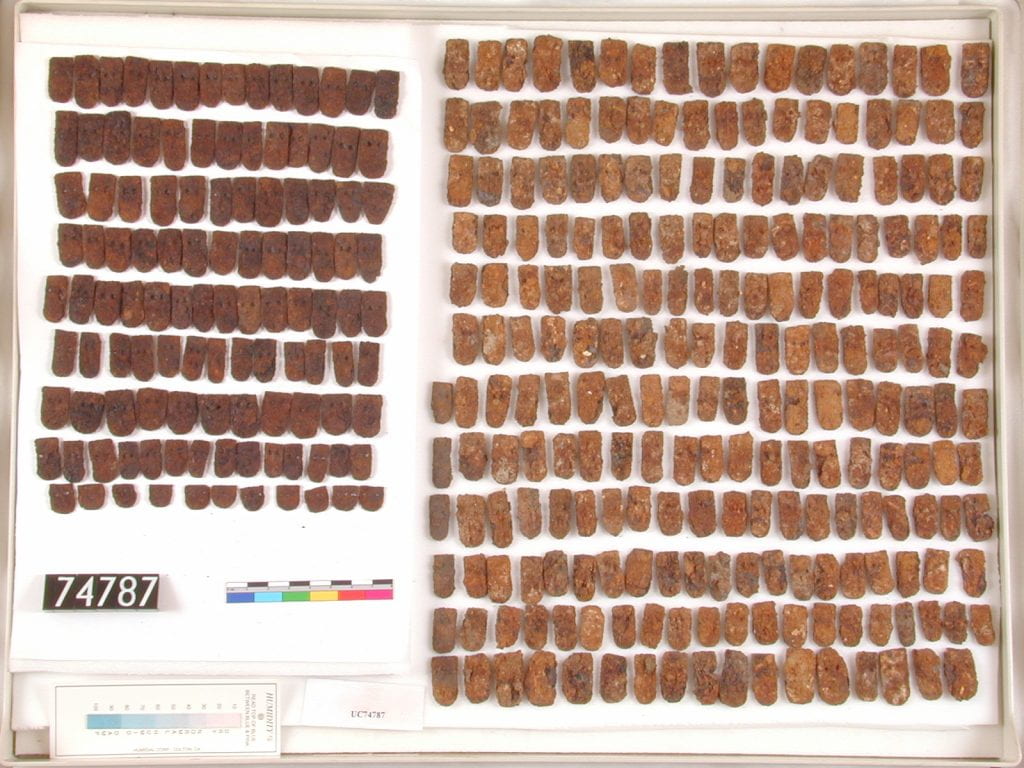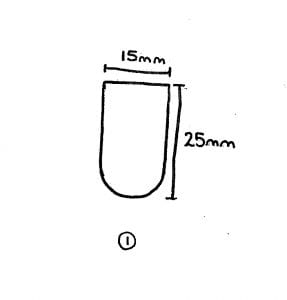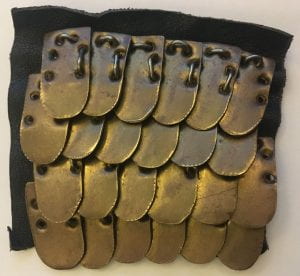Specimen of the Week 392: Hide of the Dragon: Achaemenid Scale Armour
By edwin.wood, on 6 March 2020
Scale armour is a form of defensive garment that is made by attaching small scales to a fabric or leather undergarment in an overlapping pattern. The examples in the Petrie collection are all of metal, either copper alloy (Bronze or Brass) or iron. However, examples of rawhide scales are known from sites in Egypt, notably Tutankhamun’s tomb (Dean 2017). This type of armour is one of the earliest forms to be developed and provides a flexible but effective defence that can be easily repaired if it becomes damaged. The armour is effective against a range of attacks, protecting from projectiles, cuts and blunt force impact. When combined with a stiffened or padded undergarment the protective quality of the armour is increased.
While the ancient names for this armour have been lost we refer to it now as scale armour because of its resemblance to fish or snake scales, which overlap one another to cover the softer skin beneath. The armour depicted here is from the Achaemenid Persian period (525 – 404 BC), a time when Egypt had been conquered by the neighbouring Persian Empire. Conflict with its neighbours introduced a range of technologies to Egypt as the horse, chariot and composite bow were all adapted from enemies. This example was found in the Palace of Apries, Memphis. Some two thousand scales were found in a single room of the palace and Petrie believed them to represent different parts of garments, with the smaller scales coming from gauntlets, while the larger ones he postulates came from the upper arm, shoulder or hip (Petrie 1909, 13). It is possible that they simply represent multiple garments made from differing sized scales. They may even be parts of horse armours, whole examples of which, dating to the 3rd century AD, have been found at Dura-Europos, Syria (James 2004).
The earliest depiction of scale armour in Egypt is from the tomb of Kenamun, who died during the reign of the 18th Dynasty pharaoh, Amenhotep II (1436-1411 BC). It remained a popular armour until the medieval period in Egypt and the Middle East, long after it had fallen out of favour in Western Europe. A similar type of armour called lamellar, where small plates are attached to each other and not an under-lining, was likely developed at the same time as scale.
How to make your own!
- Cut out a scales to the desired size and quantity, a good size is 25mm long by 15mm wide. Remembering to curve the bottom edge. Historically these should be of iron, copper alloy or rawhide, but any material will do (unless you plan on battling the Achaemenid Empire).
- Punch the attachment holes through the scales, for this example use two at the top.
- Attach the scales to the backing garment either using a tough thread or wire. Remember to start at the bottom!
- Place the next row of scales above the first so that they overlap, covering the attachment point of the row below.
- Repeat until the garment is complete!

Stage 2 of the armour, the scale now has two hole punched through to allow its attachment to the lining.

Stage 3 of the armour, each scale laid overlapping so that it covers the top of the row below. The scales are then attached to the fabric garment

Advanced scale with two more holes on each long side that allow the scale to be attached to the neighbouring scale increasing its rigidity and defensive property.
References
Dean, R. 2017 Warfare and Weaponry in Dynastic Egypt Pen & Sword Archaeology: Barnsley
James, S. 2004 The excavations at Dura-Europos conducted by Yale University and the French academy of inscriptions and letters 1929-1937. Final report vii: the arms and armour and other military equipment Oxford: Oxbow Books
Petrie, W.M.F. 1909 Palace of Apries (Memphis II). UCL: London
 Close
Close




